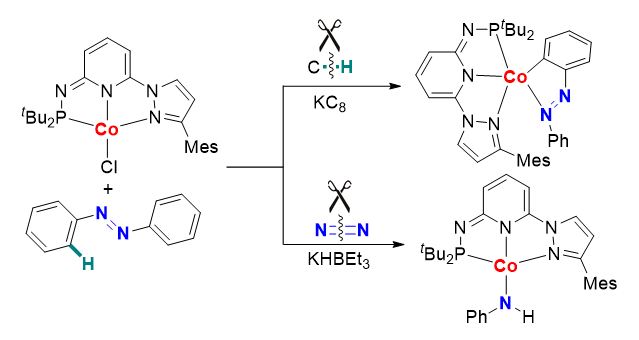Reactivities of Nonsymmetric PNN Pincer Cobalt Complex Under Reductive Conditions
還原條件下非對稱鉗形PNN钴配合物的反應性研究還原條件下非對稱鉗形PNN钴配合物的反應性研究
Yuanjin Chen, Dajiang Huang, Xianghui Shi, Zhenfeng Xi, Junnian Wei*
Acta Chimica Sinica, 2024. DOI: 10.6023/A24020060.

Nonsymmetric pincer complexes have received much attention due to their hemilability and more easily modulated spatial and electronic effects. However, their synthesis and reactivity studies remain considerably limited in comparison to symmetric pincer complexes. Common strategies to enhance the reactivity of complexes, such as reducing coordination sites or lowering metal center valences, invariably complicate synthesis. In this work, employing the strategy of introducing reducing agents, the PNNCoCl (1) (PNN: [6-(tBu2PN)C5H3N-2-(3-Mes)C3H2N2]) reacts with various small molecules to yield a variety of nonsymmetric pincer cobalt complexes, which were characterized by single-crystal X-ray diffractometry analysis and spectroscopy. The reaction of PNNCoCl, potassium graphite (or KHBEt3) with 1 equiv. of CNXyl (2,6-dimethylphenyl isocyanide) or carbon monoxide successfully yielded the monovalent cobalt complexes 2 (PNNCoCNXyl) and 3 (PNNCoCO) in 64% and 41% yields, respectively. Moreover, the reaction of complex 1 with N-heterocyclic carbene (1,3-diisopropyl-4,5-dimethyl-imidazol-2-ylidene), involving C—H bond cleavage and Co—C bond formation, afforded the corresponding divalent cobalt complex 4. Furthermore, by using different reducing agents, we achieved the modulation of the selective reaction of azobenzene C—H or N=N bonds. When KC8 (potassium graphite) was used as the reducing agent, the reaction of PNNCoCl and azobenzene in tetrahydrofuran afforded the azobenzene C—H bond-breaking product 5 in 53% yield. The cobalt atom is pentacoordinate in a tetragonal pyramid geometry. The N—N lengths of 0.12835(17) nm in complex 5 are in the range of normal N=N double bonds (0.122~0.130 nm). In contrast, the reaction of 1 with azobenzene in the presence of KHBEt3 gave the cobalt complex PNNCoNHPh (6), as confirmed by X-ray diffraction analysis. The structure suggests N=N double bond cleavage of azobenzene in the formation of the aniline complex. The N—H stretching bands of 6 were recorded at 3131 cm−1, and the solution magnetic moment was µeff = 2.2 µB. In addition, the treatment of complex 1 with 3,5-di-tert-butyl-o-benzoquinone in the presence of 1.2 equiv. of KC8 gave rise to the cobalt complex 7. X-ray diffraction analysis of 7 revealed that the PNN ligand and o-benzoquinone parts are linked by forming a P—O single bond. The o-benzoquinone was reduced to the catechol ion. Complex 7 exhibits a high-spin electronic structure (S = 3/2), as evidenced by the solution magnetic moment of 4.0 µB.
本工作報道了還原條件下, 非對稱鉗形钴配合物PNNCoCl (1) (PNN: [6-(tBu2PN)C5H3N-2-(3-Mes)C3H2N2])和有機分子的反應性. 利用PNNCoCl、還原劑與異腈或一氧化碳反應, 實現了異腈和一氧化碳配位一價钴配合物2和3的合成. 通過更換還原劑, 實現了偶氮苯C—H、N=N鍵的選擇性斷裂反應. 當使用石墨鉀作為還原劑時, PNNCoCl (1)與偶氮苯在四氫呋喃中反應, 得到偶氮苯C—H鍵斷裂産物5; 而當使用KHBEt3作為還原劑時, PNNCoCl與偶氮苯反應, 則能得到偶氮苯N=N鍵斷裂産物PNNCoNHPh (6). 此外, PNNCoCl (1)還可以與卡賓或鄰苯醌反應, 得到了相應配合物4和7. 這些配合物均通過了X射線衍射、元素分析、紅外光譜和溶液相磁化率測試等表征.




